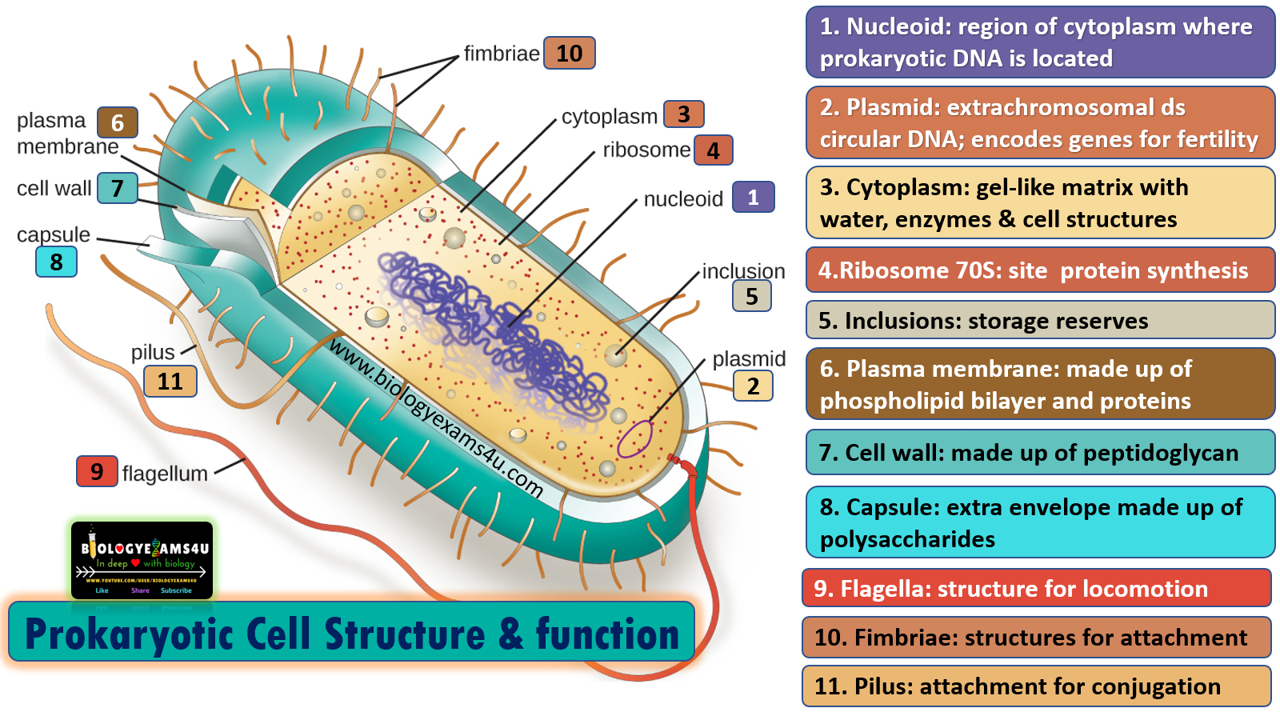Prokaryotic cell structure and function
A Prokaryote (pro: primitive or before; karyo: nucleus) is a single-celled organism that lacks a nucleus, and other membrane-bound organelles.
Prokaryotic Cell Structures and their Function Poster and PDF
Diagram Quiz on Bacterial Cell
In prokaryotes, genetic material, DNA is not surrounded by a
membrane as in true nucleus. Membrane bound organelles like mitochondria,
chloroplast etc. are also absent.
1. Nucleoid: The nucleoid
is a region of cytoplasm where the prokaryotic DNA is located. It is simply an
area of the cytoplasm where the strands of DNA are found. Most prokaryotes have
double stranded circular DNA
2. Plasmid: Plasmids
are extra chromosomal, double stranded, circular DNA molecules present in prokaryotes. Plasmids
encode genes for specific proteins like fertility factor (F plasmid), resistance
against antibiotics (R plasmids) or bacterial toxins called colicins (Col plasmid).
3. Cytoplasm: The
cytoplasm, of prokaryotic cells is where the functions for cell growth,
metabolism, and replication are carried out. It is a gel-like matrix composed
of water, enzymes, nutrients, wastes, and gases. All cell structures such as ribosomes, DNA,
and plasmids are dispersed in the cytoplasm.
4.Ribosome (70S): Prokaryotic ribosomes are 70S, involved in protein
synthesis. Ribosomes are freely distributed throughout the cytoplasm.
5. Inclusions: Cell inclusions are cytoplasmic aggregates that often store
protein or carbohydrate. It acts as storage vessels
Watch full 5 minute video here
6. Plasma membrane: Selectively permeable membrane made up of phospholipid
bilayer and proteins like eukaryotes. It encloses
the interior of the bacterium, regulating the flow of materials in and out of
the cell.
7. Cell wall: made up of peptidoglycan. It is made up of repeating N-acetylglucosamine (NAG)
and N-acetylmuramic acid (NAM) residues cross linked by small peptide
chains (amino acid chains). The wall
gives the cell its shape and surrounds the cytoplasmic membrane, protecting it
from the environment.
8. Capsule: is an extra envelope made up of complex polysaccharides.
Capsules protects the bacterium from drying out
and also protect it from phagocytosis (engulfing) by larger microorganisms.
9. Flagella: are fine long whip like structures for locomotion. Rotation of flagella propels bacteria forward. It is made up of protein called flagellin.
10. Fimbriae: are fine short bristle like structures distributed throughout
the cell surface. It is used by bacteria to adhere to one another, to hosts,
and to substances in environment.
11. Pilus (conjugation pili): helps in cell-to-cell attachment during bacterial conjugation. It is made up of pilin. It is longer than fimbriae but shorter than flagella.

